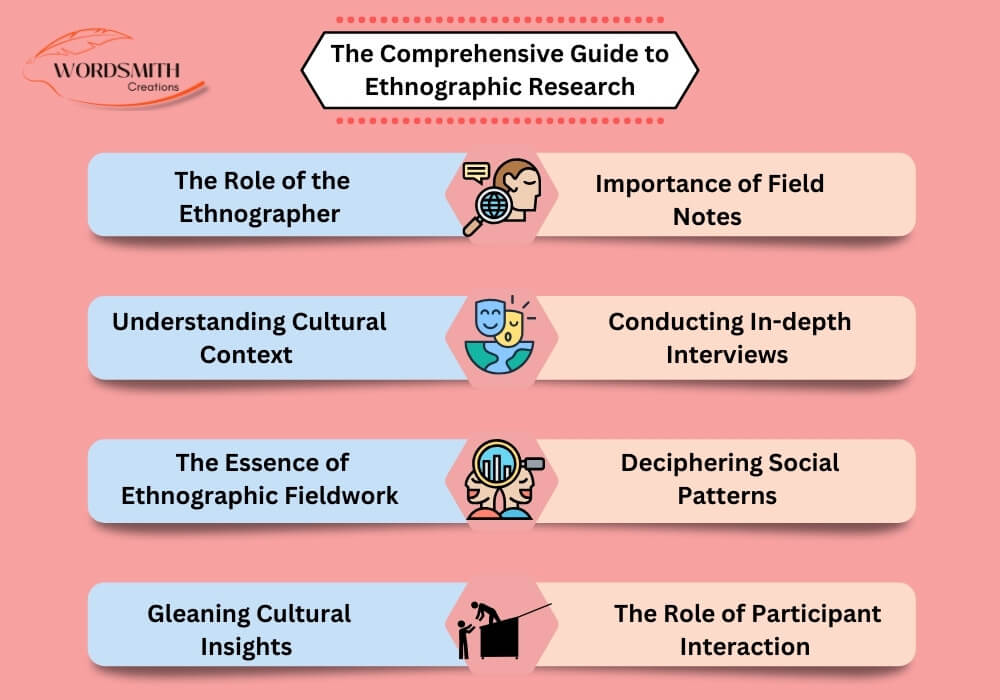
Introduction
In the realm of anthropology, ethnographic research stands as a cornerstone, offering a deep dive into the intricate web of human societies and cultures. Ethnographers, armed with their field notes, immerse themselves in diverse environments to understand the cultural context that shapes human behavior. Through in-depth interviews, they unravel the stories and experiences that define communities. This ethnographic fieldwork, often spanning months or even years, allows researchers to discern social patterns and gain cultural insights that might otherwise remain hidden.
The process is not just about passive observation. Participant interaction plays a pivotal role, ensuring that the ethnographic study is both comprehensive and authentic. The 8-step process of ethnography, a meticulous research methodology, ensures that every facet of cultural studies is explored. Fieldwork, which involves participant observation, is the heart of this qualitative research. It's where data collection happens in real-time, using a range of ethnography techniques, from simple note-taking to advanced tools tailored for ethnographic research.
Understanding how to conduct ethnographic research is crucial, not just for anthropologists but for anyone keen on understanding cultural studies. The steps in ethnography, from initial planning to ethnographic data analysis, are designed to offer a holistic view of societies. The benefits of ethnographic research are manifold, from providing a deeper understanding of communities to aiding in the design of products and services that resonate with target audiences. However, like any research method, it comes with its set of challenges in ethnography. But with best practices in place and real-world ethnographic research examples as guides, these challenges can be navigated successfully.
In today's rapidly changing world, where cultures intermingle and evolve, ethnographic research remains a beacon, illuminating the nuances of human behavior and offering insights that can bridge divides and foster understanding.

The Comprehensive Guide to Ethnographic Research
Ethnographic research, rooted deeply in the discipline of anthropology, is a qualitative research methodology that delves into the cultural context of a group or community. It seeks to understand the social patterns, cultural insights, and participant interactions by immersing the ethnographer into the lives of the subjects. This immersion, often referred to as ethnographic fieldwork, allows for an in-depth understanding of the community's practices, beliefs, and values.
1. The Role of the Ethnographer
The ethnographer is a researcher trained in anthropology or related fields, responsible for conducting the ethnographic study. They immerse themselves in the community, often living with them, to gain a firsthand understanding of their daily lives. Their primary role is to observe, interact, and document the cultural context and social patterns of the community.
2. Importance of Field Notes
Field notes are the ethnographer's primary tool for data collection. These notes capture detailed observations, in-depth interviews, and participant interactions. They serve as a record of the ethnographer's experiences and insights during the fieldwork.
3. Understanding Cultural Context
Every community operates within a specific cultural context, which influences their beliefs, values, and behaviors. Ethnographers aim to understand this context to provide a holistic view of the community's practices and traditions.
4. Conducting In-depth Interviews
In-depth interviews are essential in ethnographic research. They provide a platform for community members to share their stories, experiences, and perspectives, offering the ethnographer a deeper understanding of the community's cultural insights.
5. The Essence of Ethnographic Fieldwork
Fieldwork is the heart of ethnographic research. It involves the ethnographer living with the community, participating in their daily activities, and observing their social patterns. This immersive experience allows for a genuine understanding of the community's way of life.
6. Deciphering Social Patterns
By observing and interacting with the community, ethnographers can identify social patterns, such as rituals, ceremonies, and daily routines. These patterns offer insights into the community's cultural and social dynamics.
7. Gleaning Cultural Insights
Ethnographic research aims to uncover cultural insights that might not be evident at the surface level. These insights can range from deep-seated beliefs to subtle nuances in behavior and interaction.
8. The Role of Participant Interaction
Participant interaction is crucial for ethnographers. By actively participating in the community's activities, ethnographers can experience the community's life firsthand, leading to richer and more authentic data.
9. Crafting the Ethnographic Study
Once the fieldwork is complete, the ethnographer compiles the data into an ethnographic study. This study provides a comprehensive overview of the community, backed by field notes, interviews, and observations.
10. Tools and Best Practices in Ethnography
Modern ethnography has evolved with the integration of various tools for data collection and analysis. While traditional methods remain foundational, digital tools and software aid in ethnographic data analysis, making the process more efficient. Adhering to best practices ensures the authenticity and reliability of the research findings.
Conclusion
Ethnographic research offers a window into the intricate world of communities, revealing the intricacies of their cultural fabric. By understanding the steps in ethnography and the challenges it presents, researchers can harness its benefits, providing valuable cultural analysis and insights. Whether you're looking to conduct ethnographic research or delve into understanding cultural studies, this guide serves as a comprehensive starting point.
Ethnographic Research Case Study: Understanding Rural Market Dynamics
Background:
In a bid to understand the intricate dynamics of a rural market in Southeast Asia, a team of ethnographers embarked on a comprehensive ethnographic study. The primary objective was to grasp the cultural context and social patterns that influenced buying behaviors in this specific region.
Methodology:
The research methodology adopted was a blend of traditional anthropology techniques and modern ethnographic research tools. The 8-step process, a well-regarded ethnographic research guide, was employed to ensure a structured approach.
- Identifying the Core Objective: The primary goal was to understand how cultural studies and local traditions influenced market dynamics.
- Formulating Research Questions: In-depth interviews were planned to delve deep into the cultural insights and social patterns.
- Finalizing the Research Location: A village known for its unique cultural context was chosen.
- Choosing the Ethnographic Research Type: Participant observation was deemed the most suitable, allowing ethnographers to immerse themselves in the community.
- Seeking Approvals: Local leaders were approached, and the purpose of the ethnographic fieldwork was explained.
- Conducting the Research: Ethnographers took detailed field notes, observing participant interaction, and daily routines.
- Analyzing Collected Data: Ethnographic data analysis was conducted, focusing on understanding cultural studies and social patterns.
- Documenting the Findings: The findings were documented, highlighting the benefits of ethnographic research and the cultural analysis derived from it.
Key Findings:
- Cultural Context: The community had a rich tapestry of traditions that influenced their buying behaviors. For instance, certain products were only bought during specific festivals.
- Social Patterns: There was a clear hierarchy in decision-making within households, which businesses needed to be aware of.
- Participant Interaction: Through participant observation, it was noted that word-of-mouth played a significant role in product popularity.
- Challenges: One of the challenges in ethnography was the initial hesitation of community members to interact openly. However, as ethnographers spent more time, trust was built.
Tools Used:
Modern tools for ethnographic research were employed, including digital recorders for interviews and specialized software for data analysis.
Closure:
Understanding how to conduct ethnographic research is crucial for businesses aiming to penetrate new markets. This study provided invaluable cultural insights, emphasizing the importance of considering local traditions and social patterns. The steps in ethnography, when followed diligently, can offer a wealth of information, making it one of the best practices in ethnography. This research serves as one of the many ethnographic research examples that highlight the depth and richness of information that can be derived from such studies.
Conclusion:
In the realm of anthropology, the role of an ethnographer is paramount. They delve deep into the cultural context of a community, often relying on in-depth interviews, meticulous field notes, and extensive ethnographic fieldwork to decipher social patterns and gain cultural insights. Participant interaction is at the heart of an ethnographic study, ensuring that the findings are rooted in genuine experiences and observations.
The 8-step process of ethnographic research, as a research methodology, offers a comprehensive guide on how to conduct ethnographic research. It emphasizes the importance of cultural studies, fieldwork, and participant observation as pivotal components. This qualitative research method is not just about data collection but also about employing ethnography techniques that provide a holistic cultural analysis.
Understanding the steps in ethnography and the benefits of ethnographic research can significantly enhance the depth and breadth of insights obtained. However, like any research guide, it's essential to be aware of the challenges in ethnography. Using the right tools for ethnographic research and adhering to best practices in ethnography can mitigate these challenges. Real-world ethnographic research examples further illustrate the practical application and impact of this method.
In the digital age, the principles of ethnography extend beyond traditional anthropology. Companies like Wordsmith Creations, an IT firm, integrate these principles into their graphic design services. By understanding cultural studies and conducting ethnographic data analysis, they ensure that their designs resonate with the target audience, reflecting their preferences, needs, and cultural nuances. In essence, the fusion of ethnography and modern design practices paves the way for more informed, culturally sensitive, and effective design solutions.